November Newsletter 2016
 I hope everyone is having a great Fall! We had such a blast at the annual Halloween Party. The Nordhoff Dance Team did an amazing job with a cool dance to "Thriller"! It was so great to see everyone enjoying the activities and seeing the kids getting dressed up. The food was also delicious! I love this time of the year and can't wait for all the fun stuff November has in store. We have fun tennis socials and tournaments. We also have a great swim combine that will be a blast!
I hope everyone is having a great Fall! We had such a blast at the annual Halloween Party. The Nordhoff Dance Team did an amazing job with a cool dance to "Thriller"! It was so great to see everyone enjoying the activities and seeing the kids getting dressed up. The food was also delicious! I love this time of the year and can't wait for all the fun stuff November has in store. We have fun tennis socials and tournaments. We also have a great swim combine that will be a blast! I'm sure you might have noticed but we have a beautiful addition to the upper part of the club. Weil Tennis has added four amazing courts that overlooks the club and swim area. It is great to see the Academy growing and we wish them and the new facility the best!
I hope everyone has a great start to the Holiday Season. Make sure to have OVAC as your headquarters to stay healthy and fit!
See Ya at the Club!
Ryan
THANKSGIVING HOURS
 Thursday, November 24th
Thursday, November 24th
7:30am-12 Noon
The Café and Kids Club will be closed Thursday, returning to regular schedule on Friday.
No Group Fitness classes Thursday, see Group Fitness Sub Schedule for limited class schedule for Friday, November 25th.
TENNIS NEWS
FROM THOMAS…The annual club doubles championships are coming up the weekend of November 4th.
Sign-up sheets and additional information can be found by the Front Desk.
Save the date!
The turkey trot mixed doubles potluck will take place on November 20th.
The first of the clay courts has been serviced and is in good playing condition.
FIRST ANNUAL OVAC CLUB TENNIS CHAMPIONSHIP
 NOVEMBER 4TH & 5TH
NOVEMBER 4TH & 5TH Friday Night Calcutta 6:00 pm
Players and friends will enjoy $5 drinks and light appetizers. Ryan, Jim and Thomas will match up players that make the teams as level as possible.
Members will bid for a team, auction style, with the total prize money going half to the winning bidding team and the other half to a scholarship program for Ojai junior tennis players.
Saturday Match Play 9:00 am
Teams will play 8 game pro sets with ad scoring. Double elimination for all players. Players will get two tickets for free drinks along with a BBQ during lunch. The tournament will be limited to a 16 draw for both Men and Ladies.
Cost $25 per player
Sign Up Today!
ANNUAL TURKEY TROT MIXED DOUBLES
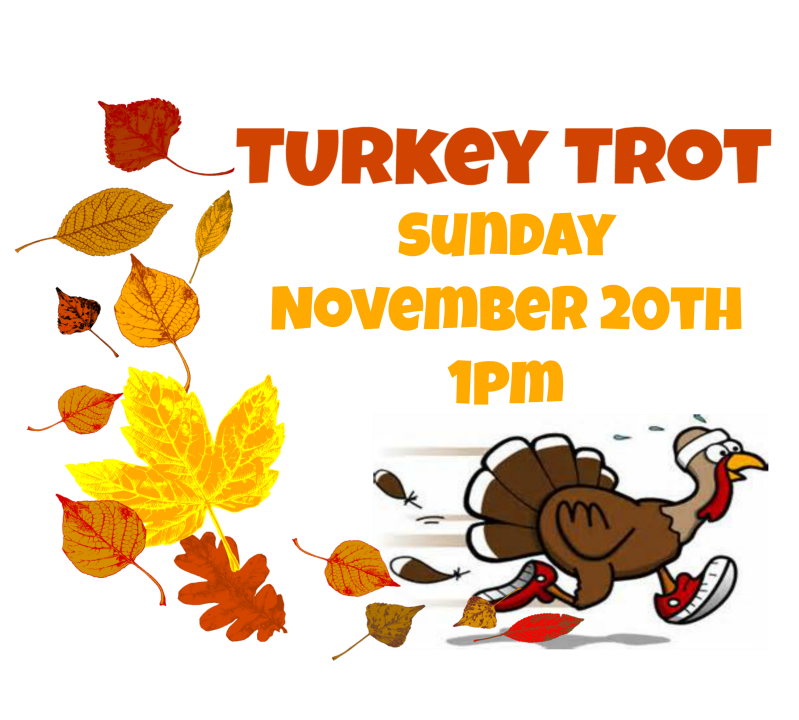 SUNDAY, NOVEMBER 20TH
SUNDAY, NOVEMBER 20TH
1PM
Complimentary Event
Reserved For Tennis Members Only
Mixed Doubles Social
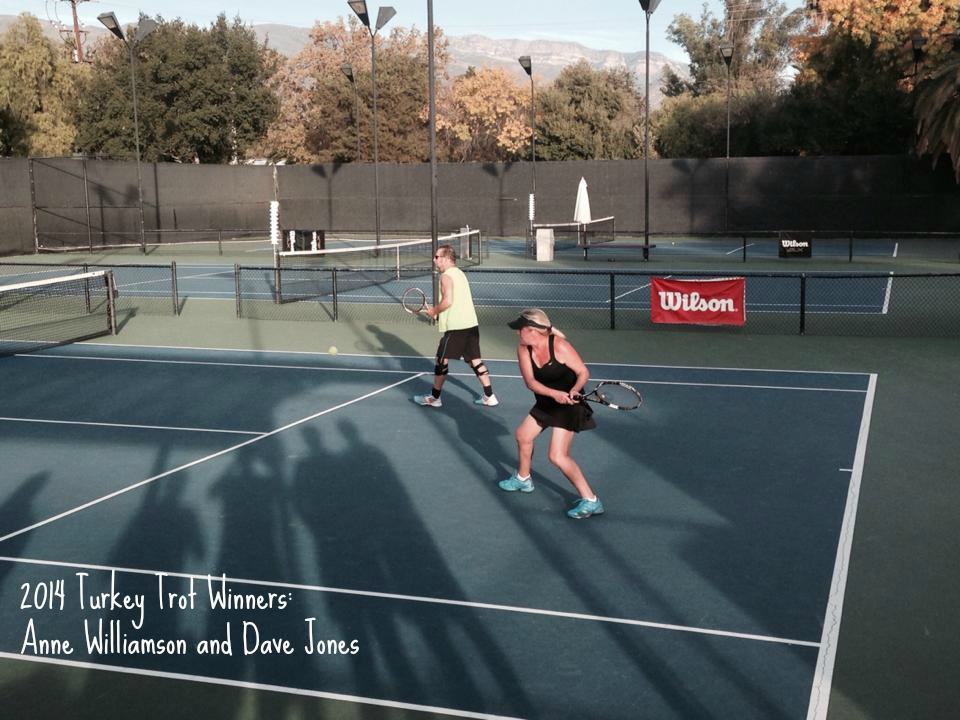
FITNESS NEWS
HOW TO LOSE WEIGHT OVER THE HOLIDAYS – ON YOUR OWNThere is a reason you have failed at your attempts to lose weight and it isn’t because of dessert. Diets aren’t black and white and neither is fat loss. The reason you have struggled is tied into your lifestyle and where you focus your efforts in your nutrition plan. There IS a healthy approach to fat loss that does not overwhelm or make too many stressful, daunting changes and this approach is available to you for the first time as the self-guided OVAC TRANSFORMATION NUTRITION PLAN FOR WEIGHT LOSS. Yes, SELF-GUIDED…we are going to teach you how to do this on your own.
The OVAC TRANSFORMATION NUTRITION PLAN FOR WEIGHT LOSS will show you how to lose fat and still indulge in desserts, days off, and daiquiris. The OVAC TRANSFORMATION NUTRITION PLAN FOR WEIGHT LOSS applies year-round, but can really help you get ready for the holidays so you can face 2017 feeling lean and fabulous.
The OVAC TRANSFORMATION NUTRITION PLAN FOR WEIGHT LOSS will help you change your mindset about fat loss, healthy eating and body transformation. You will understand what it means to be lean and healthy. What do we mean by healthy? Healthy means helping you transform your body while still enjoying your life. Healthy means helping you discover the right situation to eat the foods you love. You will learn CONSISTENCY, SUSTAINABILITY and SUCCESS.
The OVAC TRANSFORMATION NUTRITION PLAN FOR WEIGHT LOSS is a nutrition manual that can be purchased for only $99 and will be delivered to you instantly as a pdf via email. Everything you need to change your approach to nutrition and eating is contained within the manual, but if you have questions, we are here to answer your questions via email. As a bonus, we will include delicious recipe ideas designed to be healthy, nutritious, and supportive of your weight loss goals so you can stay excited and interested at mealtimes. To receive this amazing targeted and self-guided weight loss eating plan and recipes for only $99, simple email Danielle Williams at [email protected].
THE BASICS OF MACRONUTRIENTS
Macronutrients determine how many calories are in a particular item and consist of Fats, Carbohydrates and Proteins.
Fats assist in vitamin and nutrient absorption, regulate hormones and core temperature, are essential for cell and brain function, and maintain healthy, hair, skin and nails. Fats are found in oils, butters, avocados, nuts, nut butters, fatty meat/fish, dairy.
The simplest unit of fat is called the fatty acid of which there are two types: saturated (animal fats, tropical oils) and unsaturated. Unsaturated fats can then be broken down into monounsaturated (olive oil, avocados, peanuts, pecans, almonds) and polyunsaturated (Omega 3, Omega 6, flax, hemp, fish, canola oil, safflower oil). Fatty acids can be combined together to create triglycerides which is the storage form of fat in the body.
Saturated fat has long thought to be the cause of heart disease. Foods high in saturated fats (red meat, butter, eggs, cream) are often thought to be “bad”, unhealthy and something we should stay away from. However, studies are now are showing that there is no direct link between saturated fat and heart disease. Also, eating saturated fat will not automatically make you fat. But, eating at a caloric surplus (consistently eating more than your body burns) will lead to weight gain. However, a diet constantly high in only saturated fat, sugar, processed and refined carbohydrates and other poor dietary choices may in fact be a cause of excess body fat and increased risk of cardiovascular disease. Saturated fat shouldn't be considered unhealthy, unless you consume it in massive quantities out of balance with consumption of unsaturated fats.
Trans fat is usually a result of industrial fat processing. Some products contain naturally occurring trans fat configurations; however it's the chemically made versions that should be limited as high trans fat consumption is linked to higher risk of disease. Consuming a diet rich in unprocessed, whole foods makes it difficult to accumulate harmful levels of trans fat.
Carbohydrates provide energy. They are found in all fruits and vegetables, breads, grains, cereals, juices, soda, candy, most processed foods, potatoes, rice, and pasta. Many labels will break down the food's total carbohydrates further into categories. Keep in mind that all sugars, starches and fibers are considered carbs.
Fiber is important for many bodily functions, namely digestion. Consuming an adequate amount (somewhere between 20-40 grams) of fiber a day is necessary for optimal gut and overall health. By consuming fruits, veggies, certain whole grains, legumes, nuts and seeds you can meet these daily requirements (as evidenced by daily bowel movements).
Don’t forget that sugar can occur from naturally occurring sources (lactose, fructose, etc.). You may also come across sugar alcohols that are used as sweeteners. Sugar alcohols can be found both naturally (in fruits and veggies) and in industrial produced form (in things like sugar free foods and drinks and candies). Examples of sugar alcohols include xylitol, erythritol, sorbitol and maltitol. Sugar alcohols can cause digestive issues, like gas and bloating, especially when consumed in large quantities but selling points include the fact that they are usually lower in calories and won't contribute to tooth decay as sugar does. Research is still somewhat sparse on the possible ill effects of sugar alcohols, but like most food items, they are perfectly fine in moderation. As part of the FDA's new regulations, items that contain sugar alcohols will have to be listed as Added Sugars. Should you limit them? Not necessarily. Remember that body composition is a matter of overall caloric intake, regardless of where those calories are coming from. All of your carbohydrates shouldn’t come from sugary foods alone, but there’s no reason to cut them out completely.
Some food labels show Net Carbs. Net Carbs are calculated by subtracting the amount of fiber and sugar alcohols from a food item's total carbohydrates and. As fiber isn't digestible, it does not have an impact on blood sugar levels nor does it trigger an insulin response (both of which occur after consuming carbs), so many manufacturers list net carbs on their labels to make the food more appealing to those who are following low carb diets. The thought is that net carbs reflect only the carbohydrates which will have an effect on blood sugar. Some calculating their carb intake may believe that subtracting fiber and sugar alcohols will allow them to be able to eat more carbohydrates to make up for what they've subtracted. However, keep in mind that there is no legal definition for net carbs (the FDA doesn't regulate them), many food labels are grossly inaccurate, and while insoluble fiber isn't digestible, soluble fiber is and has 2-4 calories per gram. Pay attention to a food's total carbohydrates and don't worry about calculating net carbs.
Protein controls appetite and hunger. Eating appropriate/ high(er) amounts of protein will allow you to feel fuller longer thanks to a high satiety factor which is extremely helpful during a fat loss diet. Protein helps build muscle, fuel muscle protein synthesis and prevents muscle loss, especially during periods of caloric deficit. Compared to carbohydrates and fats, your body uses more energy while digesting protein. So eating an adequate amount of protein, especially when trying to lose weight, will help you burn more calories overall. Protein is found in chicken, beef, fish, pork, eggs, egg whites, protein powders (whey, casein, soy, pea, hemp, etc.), tofu, seitan, yogurt & other dairy products. There are many foods that contain trace amounts of protein. Even a standard size packet of M&M’s has 2 grams of protein and items like breads, cereals, cookies, beans and veggies contain protein as well. However, these items usually contain more carbohydrates than protein. Nuts and nut butters are also often marketed as great sources of protein. They’re not. Nuts & nut butters DO have protein, but the amount per serving is not significant enough to be considered an excellent or high source. These should be predominantly considered a fat source.
Each of the macronutrients contain a certain number of calories and are listed in grams on a food label:
1 gram of protein = 4 calories
1 gram of carbohydrate = 4 calories
1 gram of fat = 9 calories1 gram of alcohol = 7 calories
HOLIDAY TRAINING SPECIAL
 3 FOR $120 ONE-ON-ONE PERSONAL TRAINING
3 FOR $120 ONE-ON-ONE PERSONAL TRAINING
THE GIFT OF HEALTH: Share with someone you care for the benefits of exercise with a GIFT CERTIFICATE. Or better yet, treat yourself to this special offer! Valid for members not currently working with a personal trainer. All sessions must be used by January 31st, 2017. A member may only use one 3-pack special., but may purchase more than one for others. Gift Certificates are available by contacting Fitness Director Danielle Williams at [email protected] or 818-219-4835. (Note that not all personal trainers are available for this special).
CONGRATULATIONS 2016 TEAM 100
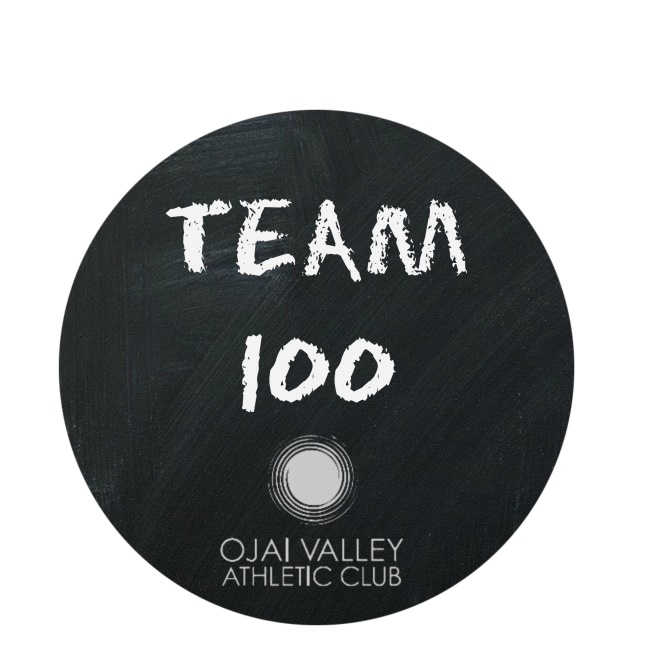 FOR COMPLETING 100 WORKOUTS IN A CALENDAR YEAR
FOR COMPLETING 100 WORKOUTS IN A CALENDAR YEAR
Susan Amend
GT Banahan
Jerry Barnes
Cecil Baumgartner
Jack Bertsch
Gayle Childress
Jeannine Carter
Stephen Carter
Mike Caldwell
Anne Carper
Anne Charlesworth
Jim Christiansen
Ing-Marie Currie
Don Diaz
Fred Fauvre
Frank Fink
Maudette Fink
Sue Francis
Robin Granholm
Mary Iler
Robin Johnston
June Juett
Mike Juett
Nancy Kocheavar
Donna Lechman
Maralisa Long
Gail Moore
Rick Moore
Janet Owens
Jenny Owens
Richard Parsons
Tim Peddicord
Nancy Prather
Ann Robertson
Pete Scharff
Bonnie Scharff
Corkey Solow
Dan Sommer
Terry Tallent
Anna Thomas
Mike Urbanek
Dennis Wood
Peggy Wood
Aquatics
Masters Swimming at OVAC-All abilities welcome!!
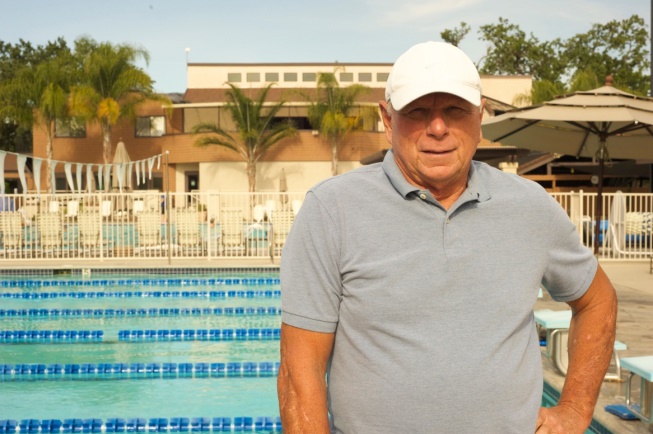 Coach Rick Goeden coaches OVAC ‘s Masters Swim Program. Rick has over 30 years coaching experience coaching and has taken the OJAI Masters to win SPMA’s regionals five times. He has also led many individuals to Southern Pacific Top Tens and USMS National Top Tens.
Coach Rick Goeden coaches OVAC ‘s Masters Swim Program. Rick has over 30 years coaching experience coaching and has taken the OJAI Masters to win SPMA’s regionals five times. He has also led many individuals to Southern Pacific Top Tens and USMS National Top Tens.
 Mondays – Wednesdays – Fridays
Mondays – Wednesdays – Fridays
6:00am Masters/ 9:00am Technique Class/ 12:00 noon Lunch Bunch
Tuesdays – Thursdays
8:30am Masters
Saturdays 7:30am Masters I
For More Information Contact Rick Geoden [email protected]

NO YOUTH SWIM CLASSES THANKSGIVING WEEK
November 21-25
All lanes will be available for lap swimming those afternoons. Enjoy!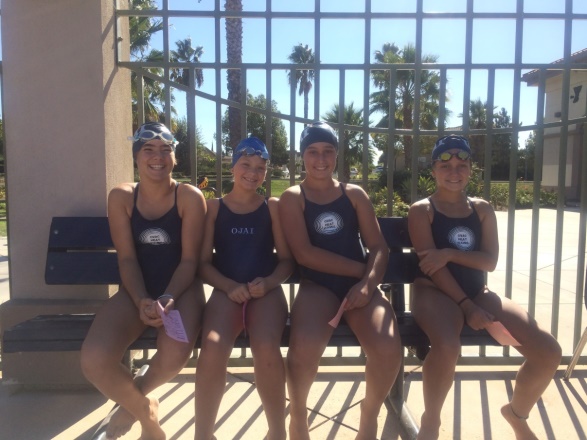
OVAC Heat Wave Swimmers Alex Gonzales, Emerald Johnson, Ela Ruf and Josephine Hartman
11-12 Girls Free Relay compete in Camarillo.
TENNIS AND PILATES
BY JULIE FOX, PILATES INSTRUCTOR
Mental toughness. We all have to have it in different degrees just getting through life. It keeps us going, not allowing us to give up, whether it is competing in sports, a work situation or a relationship. It is the edge that is needed when competing in tennis or any sport and, for that matter, in our work life. The discipline an athlete has in their fitness routine contributes to that mental toughness when competing:
“It started with an instinctive love of tennis. Competitions, wear and tear, and experience slowly made me aware of the amazing complexity and intelligence of the body. The discovery of Pilates gave me a second love that improved my tennis and my quality of life.”
OVAC Tennis player and Pilates client, Susan Kasser says, “"Pilates has increased my core strength and flexibility enormously! By focusing on these I am able to hit a much better ball"
Tennis is a high speed, high impact, power-based game requiring rotation and extension through the spine and putting particular stress on the shoulder – usually one, rather than both. Back, hip, knee and shoulder injuries are among the most common. Whether you’re a social player or a budding pro, Pilates can improve your movement, power and, ultimately your game itself. Also, Pilates can help reduce the number of common tennis injuries. The following are some excerpts from tennis pros and the like who tell of the benefits of Pilates.
Andy Murray, Serena Williams and Pat Cash all swear by it. Pilates Foundation teacher, Vivian Gabb, discusses the injuries that can occur during a tennis player’s serve and explains how Pilates can help. “I know from my experience as a tennis player and coach for 30 years that tennis at a high level puts the body under enormous strain. After I played a grueling first ‘futures’ tournament match some 27 years ago, I came off the court barely able to move. I was in a lot of pain. The tournament physiotherapist diagnosed the beginning of a prolapsed disc. She warned me that if I didn’t change my serve action, I would not be playing tennis for very long. Other tennis injuries followed. They didn’t realize how fit they needed to be to play competitively, and overuse injuries occurred. They hardly left time for their body to heal. It went from small nagging aches to debilitating injuries and eventually operations. After one operation for a knee meniscal tear, the surgeon suggested trying to integrate Pilates into my fitness routine. After doing some research, I found some of Pat Cash’s testimonials about Pilates: ‘I was amazed at how gentle, yet totally effective the exercises were. With Pilates, I was able to continue playing tennis at the top level and the exercises remain a key part of my exercise program.’
Pilates has become part of the fitness routine of players including Serena Williams and Andy Murray. During his 2012 ATP World Tour Finals preparation, Andy Murray was reported in The Daily Express as saying, ‘I started doing Pilates a few weeks ago which has already helped. I did three or four Pilates sessions and my body feels good compared to the last few years … I have practiced well the last few days and not been waking up with soreness or stiffness.’
The serve
How it works according to Bette Pluim and Marc Safran in From “Breakpoint to Advantage”, the serve’s main component is ‘the instant in which the racket meets the ball at peak height … meaning the dominant arm is at full stretch above the head. At this stage all the muscles are working to discharge the energy that has been stored within each cell toward the ball.’ If the ball is accurately served into the receiver’s court, the point is in play. If however, through some muscular imbalance, the ball is over-hit or put into the net, a second serve is allowed. In the loading phase, the player prepares, visualizing the service action and where they want to direct the ball. This could be repeated 300 times in a set, so rhythm, coordination and fluidity are crucial. The sequence is initiated by knee flexion. The player’s arm extends into the ball toss. In a right-handed player, the racquet arm moves to the right side of the body and the trunk follows. This trunk rotation starts the coiling effect to the body.
When Serena Williams serves, she transfers her weight back as she pushes into the ground for power. Her knees bend. She moves her racquet into ‘the throwing’ position. Her spine goes into hyperextension. Her feet begin to leave the ground. Serena’s dominant shoulder and elbow are in external rotation. She prepares to extend up to the ball. Her accumulated power is released. Then comes the explosive acceleration phase. Serena goes to the maximum elevation of her body. Her trunk and shoulder are into internal rotation. She is in the air. She hits the ball. (Her strong core muscles prevent her upper body from collapsing.) The power started from ground reaction forces is now transferred from the legs to the hips/pelvis/trunk through the middle and upper back, then into the shoulder, arm, wrist and ultimately to the racquet and ball. She follows through. She lands on her left foot inside the baseline. Her racquet arm and shoulder decelerate. The explosive nature of the serve means that a player can be vulnerable to injury. With this sudden burst of energy from the serve, it is not surprising that this particular tennis action is the most likely stroke to cause injury.
The spine
In tennis, much of the power comes from rotation and extension through the spine. To produce these movements you need a mixture of strength and flexibility. Pilates will help loosen some of the typically tight muscles through the chest, shoulders and upper back, while strengthening the muscles through the waist. This increase in both the strength of the rotator muscles and the range of motion combines to generate more power through your strokes.
Flexibility and suppleness
No matter what level you play at, you’re often trying to return a ball from an imperfect position, stretching forwards, sideways or overhead and frequently off-balance. Pilates’ focus on strong core muscles will help you generate more power and reduce the risk of injury when you’re off balance, and recover your balance faster. And by increasing flexibility through the lower back, and hips, Pilates will also help you get down lower for the drop shots and up higher for the lobs.
Knee injury: Knee pain can occur when extending during the service action or when landing on one leg after hitting the ball. The knee can be vulnerable if it lacks the strength and flexibility needed to transmit the energy and absorb the impact. Injuries may be caused by repetitive wear and tear or by an imbalance in the muscles of the leg. Pilates exercises: To correct this imbalance of the muscle in the legs, the following exercises can be used: On the Reformer: The footwork series to strengthen the back and the front of the leg. Foot and ankle joint motion and control exercises. On the Wunda Chair: Calf raises for calf strengthening and flexibility and hamstring stretches.
Shoulder injuries: Strain on the shoulder occurs at the acceleration phase of the serve because high forces act on the shoulder joint to pull the arm forward. The shoulder is the most mobile joint of the body, but also the least stable. The repetitive pulling of the rotator cuff tendons, particularly the supraspinatus muscle, may lead to inflammation, pain and a tear. The tell-tale symptom for this condition is usually the pain caused by bringing the arm away from the body. Further symptoms may be weakness of the shoulder and the inability to lift the arm above the shoulder. Pilates exercises: On the Reformer: Arms kneeling to strengthen the rotor cuff and enhance scapular stabilization and strengthen the wrist. On the Cadillac: Hug a tree and Circles which increases the range of motion in the glenohumeral joint.
“It started with an instinctive love of tennis. The discovery of Pilates gave me a second love that improved my tennis and my quality of life.”


